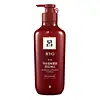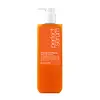What's inside
What's inside
 Key Ingredients
Key Ingredients

 Benefits
Benefits

 Concerns
Concerns

 Ingredients Side-by-side
Ingredients Side-by-side

Water
Skin ConditioningCetyl Alcohol
EmollientStearyl Alcohol
EmollientDimethicone
EmollientBehentrimonium Chloride
PreservativeParfum
MaskingIsopropyl Alcohol
SolventDipentaerythrityl Hexahydroxystearate/Hexastearate/Hexarosinate
Skin ConditioningAmodimethicone
Glyceryl Caprylate
EmollientEthylhexylglycerin
Skin ConditioningDisodium EDTA
Hexyl Cinnamal
PerfumingBenzyl Benzoate
AntimicrobialLinalool
PerfumingLimonene
PerfumingSteartrimonium Chloride
PreservativeButylene Glycol
HumectantCamellia Japonica Seed Oil
EmollientPunica Granatum Fruit Extract
AntioxidantLactic Acid
BufferingSodium Benzoate
MaskingTocopherol
AntioxidantAlcohol
AntimicrobialArgania Spinosa Kernel Oil
EmollientHelianthus Annuus Seed Oil
EmollientCamellia Sinensis Seed Oil
HumectantPPG-3 Caprylyl Ether
SolventGlycolipids
Skin ConditioningGlycyrrhiza Glabra Root Extract
BleachingXylitylglucoside
HumectantAnhydroxylitol
HumectantXylitol
HumectantCamellia Sinensis Leaf Extract
AntimicrobialCornus Officinalis Fruit Extract
Skin ConditioningPanax Ginseng Root Extract
EmollientZingiber Officinale Root Extract
MaskingDipropylene Glycol
HumectantNelumbo Nucifera Flower Extract
Skin ConditioningPaeonia Lactiflora Root Extract
Skin ConditioningRehmannia Glutinosa Root Extract
Skin ConditioningRoyal Jelly Extract
Skin ConditioningGlucose
HumectantHoney
HumectantLilium Candidum Bulb Extract
Skin ConditioningPhenoxyethanol
PreservativeAcetic Acid
BufferingSchisandra Chinensis Fruit Extract
Skin ConditioningTrideceth-10
CleansingPolygonatum Odoratum Rhizome Extract
Skin ConditioningWater, Cetyl Alcohol, Stearyl Alcohol, Dimethicone, Behentrimonium Chloride, Parfum, Isopropyl Alcohol, Dipentaerythrityl Hexahydroxystearate/Hexastearate/Hexarosinate, Amodimethicone, Glyceryl Caprylate, Ethylhexylglycerin, Disodium EDTA, Hexyl Cinnamal, Benzyl Benzoate, Linalool, Limonene, Steartrimonium Chloride, Butylene Glycol, Camellia Japonica Seed Oil, Punica Granatum Fruit Extract, Lactic Acid, Sodium Benzoate, Tocopherol, Alcohol, Argania Spinosa Kernel Oil, Helianthus Annuus Seed Oil, Camellia Sinensis Seed Oil, PPG-3 Caprylyl Ether, Glycolipids, Glycyrrhiza Glabra Root Extract, Xylitylglucoside, Anhydroxylitol, Xylitol, Camellia Sinensis Leaf Extract, Cornus Officinalis Fruit Extract, Panax Ginseng Root Extract, Zingiber Officinale Root Extract, Dipropylene Glycol, Nelumbo Nucifera Flower Extract, Paeonia Lactiflora Root Extract, Rehmannia Glutinosa Root Extract, Royal Jelly Extract, Glucose, Honey, Lilium Candidum Bulb Extract, Phenoxyethanol, Acetic Acid, Schisandra Chinensis Fruit Extract, Trideceth-10, Polygonatum Odoratum Rhizome Extract
Water
Skin ConditioningGlycerin
HumectantDipropylene Glycol
HumectantCetyl Alcohol
EmollientStearyl Alcohol
EmollientDimethicone
EmollientBehentrimonium Chloride
PreservativeIsopropyl Alcohol
SolventParfum
MaskingHydroxyethylcellulose
Emulsion StabilisingEthylhexylglycerin
Skin ConditioningDisodium EDTA
Hc Yellow No. 4
CI 19140
Cosmetic ColorantTocopherol
AntioxidantArgania Spinosa Kernel Oil
EmollientAbies Alba Seed Oil
AntimicrobialOlea Europaea Fruit Oil
MaskingSimmondsia Chinensis Seed Oil
EmollientCamellia Seed Oil
Cocos Nucifera Oil
MaskingCI 17200
Cosmetic ColorantBlue 1 Lake
Cosmetic ColorantCoco-Caprylate/Caprate
EmollientSclerocarya Birrea Seed Oil
HumectantGlycolipids
Skin ConditioningWater, Glycerin, Dipropylene Glycol, Cetyl Alcohol, Stearyl Alcohol, Dimethicone, Behentrimonium Chloride, Isopropyl Alcohol, Parfum, Hydroxyethylcellulose, Ethylhexylglycerin, Disodium EDTA, Hc Yellow No. 4, CI 19140, Tocopherol, Argania Spinosa Kernel Oil, Abies Alba Seed Oil, Olea Europaea Fruit Oil, Simmondsia Chinensis Seed Oil, Camellia Seed Oil, Cocos Nucifera Oil, CI 17200, Blue 1 Lake, Coco-Caprylate/Caprate, Sclerocarya Birrea Seed Oil, Glycolipids
 Reviews
Reviews

Ingredients Explained
These ingredients are found in both products.
Ingredients higher up in an ingredient list are typically present in a larger amount.
You may know this ingredient as argan oil. Argan Oil has antioxidant, hydrating, and soothing properties.
Studies have shown argan oil can help fight again radical damage from the sun. This makes it effective at preventing hyperpigmentation.
Large amounts of vitamin E found in argan oil helps the skin retain water. Argan oil also contains fatty acids such as linoleic acid, oleic acid, and palmitic acid. It is also a good source of lipids.
Another benefit of argan oil is skin-soothing. It can help reduce inflammation-related skin symptoms.
Argan Oil is effective at regulating sebum production in pores. This can make it effective at treating hormonal acne.
Traditionally, argan oil was used for its antibacterial and antifungal properties. However, argan oil contains fatty acids that may make it not fungal-acne safe.
Argan Trees are native to Morocco.
Learn more about Argania Spinosa Kernel OilThis ingredient is a preservative and often used for it's anti-static properties. You'll most likely see this ingredient in hair conditioners.
It does not cause irritation or sensitization in leave-on products at 1-5%.
Cetyl Alcohol is a fatty alcohol. Fatty Alcohols are most often used as an emollient or to thicken a product.
Its main roles are:
Though it has "alcohol" in the name, it is not related to denatured alcohol or ethyl alcohol.
The FDA allows products labeled "alcohol-free" to have fatty alcohols.
Learn more about Cetyl AlcoholDimethicone is a type of synthetic silicone created from natural materials such as quartz.
What it does:
Dimethicone comes in different viscosities:
Depending on the viscosity, dimethicone has different properties.
Ingredients lists don't always show which type is used, so we recommend reaching out to the brand if you have questions about the viscosity.
This ingredient is unlikely to cause irritation because it does not get absorbed into skin. However, people with silicone allergies should be careful about using this ingredient.
Note: Dimethicone may contribute to pilling. This is because it is not oil or water soluble, so pilling may occur when layered with products. When mixed with heavy oils in a formula, the outcome is also quite greasy.
Learn more about DimethiconeDipropylene Glycol is a synthetically created humectant, stabilizer, and solvent.
This ingredient helps:
Dipropylene glycol is technically an alcohol, but it belongs to the glycol family (often considered part of the ‘good’ alcohols). This means it is hydrating and gentle on skin unlike drying solvent alcohols like denatured alcohol.
As a masking agent, Dipropylene Glycol can be used to cover the smell of other ingredients. However, it does not have a scent.
Studies show Dipropylene Glycol is considered safe to use in skincare.
Learn more about Dipropylene GlycolDisodium EDTA plays a role in making products more stable by aiding other preservatives.
It is a chelating agent, meaning it neutralizes metal ions that may be found in a product.
Disodium EDTA is a salt of edetic acid and is found to be safe in cosmetic ingredients.
Learn more about Disodium EDTAEthylhexylglycerin (we can't pronounce this either) is commonly used as a preservative and skin softener. It is derived from glyceryl.
You might see Ethylhexylglycerin often paired with other preservatives such as phenoxyethanol. Ethylhexylglycerin has been found to increase the effectiveness of these other preservatives.
Glycolipids are natural, sustainable biosurfactants. They are both surfactants (cleansing agents) and emollients.
Made from lipids and sugars, in-vitro studies show glycolipids are a gentle alternative to conventional surfactants. They also possess foaming properties to give cleaning products a nice texture.
One manufacturer study found their glycolipid also demonstrated sebum reduction and helped reduced oiliness after four weeks. This means it can also be great for scalp care.
Learn more about GlycolipidsIsopropyl Alcohol is more commonly known as rubbing alcohol. It is most commonly used as a solvent, meaning it helps other ingredients dissolve.
This ingredient is an astringent alcohol. Astringent alcohols may also irritate skin as they high amounts may strip away your skin's natural oils.
Other types of astringent alcohols include:
According to the National Rosacea Society based in the US, you should be mindful of products with these alcohols in the top half of ingredients.
Any type of sanitizing product will have high amounts of alcohol to help kill bacteria and viruses.
Learn more about Isopropyl AlcoholParfum is a catch-all term for an ingredient or more that is used to give a scent to products.
Also called "fragrance", this ingredient can be a blend of hundreds of chemicals or plant oils. This means every product with "fragrance" or "parfum" in the ingredients list is a different mixture.
For instance, Habanolide is a proprietary trade name for a specific aroma chemical. When used as a fragrance ingredient in cosmetics, most aroma chemicals fall under the broad labeling category of “FRAGRANCE” or “PARFUM” according to EU and US regulations.
The term 'parfum' or 'fragrance' is not regulated in many countries. In many cases, it is up to the brand to define this term.
For instance, many brands choose to label themselves as "fragrance-free" because they are not using synthetic fragrances. However, their products may still contain ingredients such as essential oils that are considered a fragrance by INCI standards.
One example is Calendula flower extract. Calendula is an essential oil that still imparts a scent or 'fragrance'.
Depending on the blend, the ingredients in the mixture can cause allergies and sensitivities on the skin. Some ingredients that are known EU allergens include linalool and citronellol.
Parfum can also be used to mask or cover an unpleasant scent.
The bottom line is: not all fragrances/parfum/ingredients are created equally. If you are worried about fragrances, we recommend taking a closer look at an ingredient. And of course, we always recommend speaking with a professional.
Learn more about ParfumStearyl Alcohol is a type of fatty alcohol from stearic acid. It is a white, waxy compound used to emulsify ingredients.
Fatty Alcohols are most often used as an emollient or to thicken a product. Emollients help soothe and hydrate the skin by trapping moisture.
They are usually derived from natural fats and oils and therefore do not have the same drying or irritating effect as solvent alcohols. FDA allows products labeled "alcohol-free" to have fatty alcohols.
Learn more about Stearyl AlcoholTocopherol (also known as Vitamin E) is a common antioxidant used to help protect the skin from free-radicals and strengthen the skin barrier. It's also fat soluble - this means our skin is great at absorbing it.
Vitamin E also helps keep your natural skin lipids healthy. Your lipid skin barrier naturally consists of lipids, ceramides, and fatty acids. Vitamin E offers extra protection for your skin’s lipid barrier, keeping your skin healthy and nourished.
Another benefit is a bit of UV protection. Vitamin E helps reduce the damage caused by UVB rays. (It should not replace your sunscreen). Combining it with Vitamin C can decrease sunburned cells and hyperpigmentation after UV exposure.
You might have noticed Vitamin E + C often paired together. This is because it is great at stabilizing Vitamin C. Using the two together helps increase the effectiveness of both ingredients.
There are often claims that Vitamin E can reduce/prevent scarring, but these claims haven't been confirmed by scientific research.
Learn more about TocopherolWater. It's the most common cosmetic ingredient of all. You'll usually see it at the top of ingredient lists, meaning that it makes up the largest part of the product.
So why is it so popular? Water most often acts as a solvent - this means that it helps dissolve other ingredients into the formulation.
You'll also recognize water as that liquid we all need to stay alive. If you see this, drink a glass of water. Stay hydrated!
Learn more about Water